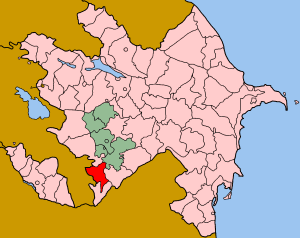| Revision as of 08:47, 13 February 2008 editBakulas (talk | contribs)78 edits →Etnhic Groups← Previous edit | Revision as of 08:48, 13 February 2008 edit undoBakulas (talk | contribs)78 edits →Etnhic GroupsNext edit → | ||
| Line 69: | Line 69: | ||
| | titlebar=#ddd | | titlebar=#ddd | ||
| | bars= | | bars= | ||
| {{bar percent|Azeris|brown| |
{{bar percent|Azeris|brown|52}} | ||
| {{bar percent|Kurds|orange| |
{{bar percent|Kurds|orange|48}} | ||
| }} | }} | ||
Revision as of 08:48, 13 February 2008
 | |
| Population: | 31.504 |
| Area (sq. km.): | 802 |
| Majority people | Azeri 86.6%,Kurdish 13.4% |
| Majority speaking | Azerbaijani |
| Religion | Islam |
| Capital: | Qubadli |
| Number of villages | 93 |
| Number of towns | 1 |
History
The Gubadly region was established in 1933. Its area is 802 km2 and population is 31504 people (data for January 2005). Geographical position :
The region locates in the south-west of the Republic of Azerbaijan in the mountainous area and foothills. The highest point is Toragaj 2003 m high from the sea level. The climate is temperate continental. Ever-flowing rivers of Hakari and Bargushad cross the territory of the region. Gubadly region is bordered on the republic of Armenia along 120 km in the west, on Lachin and Hadrut regions in the north, on Jabrail region in the east and on Zangilan region in the south.
The population is composed of the Azerbaijanis that settled in 93 villages and the centre of the region Gubadly city.
Majority of the villages locate around the rivers Hakari and Bargushad. One can also notice the villages on the mountainous areas and foothills.
Gubadly is an agricultural region. People engaged here with grain-, wine-, tobacco- and melon growing as well as animal breeding.
The industry had in the recent years been fixing in the economy of the region.
Cubadli is a place of old human settlement. Though the territory has not been thoroughly studied yet, natural caves, shelters still preserved the signs of human work. Impassable rocks, defending fortifications rose on them and the remnants of the guard towers have still remained to our days.
Ancient sacred places prove the permanent settlement much ago Islam. This fact is also proved by the old graveyards, samples of the everyday life equipment and tools found near separate settlements. Ancient samples of the material culture inform about the development of cultivation and animal-breeding in this territory.
"Khirman yeri" found in the territory of Gubadly city, "Galacha", "Koroglu tower" in the village Aliquluushagi, "Cattle hill" in the territory of Muradkhanli refer to the Late Bronze and Early Iron Age.
Small fortifications remained on the impassable rocks in the villages Saray, Poladli, Khojamsakhli and Chardakhli are separately referred to the 7th-9th century. But the real fact is that those fortifications were the part of the unique guarding points system along the borderline between Atropatena and Albania in the 1st century B.C.
In the passed century Gubadly was constantly attacked by the Armenian invaders (1915, 1918 and 1920). The villages of Gubadly were burnt together with those of the Zangazur, people suffered damages. Despite of all difficulties the Armenian invaders were driven out of our lands.
Invasion attacks from the both sides against Gubadly region, locating on the borderline between Armenia(120 km) and Daglig Garabag (45 km), started from 1988. Peaceful population of the region suffered terror acts.
During 5 year long war till late August, 1993 Gubadly region gave 238 martyrs. 9 of them posthumously deserved the name of the National Hero of Azerbaijan.
After occupation of lachin, Agdam, Fuzuli and Jabrail Gubadly region was in partial blockade and in 30-31 August, 1993 it was occupied by the Armenian invaders. More than 30 000 Gubadly nhabitants urged to leave their homes and they settled in 2 cities and regions of the republic as IDPs.
Armenian invaders robbed and destroyed the private and social property in the cost USD 1.2 billion (with the prices of 1993).
Many prominent people of Azerbaijan were bred in Gubadli. Two of the national heroes of Azerbaijan-Gachag Nabi and Hajar were from Gubadli.
Etnhic Groups
| ||||||||||||||||||||
Historical, Cultural and Architectural monuments destrucuted as a result of Armenian aggression
- 1. Goy gala (blue tower) 5th century
- 2. Lalezar bridge 1867
- 3. Burial-vault 17th century
- 4. 1st burial-vault 14th century
- 5. 2nd burial-vault 14th century
- 6. Habitation Khirman yeri Late Bronze, early Iron Age
- 7. Koroglu tower Late Bronze, early Iron Age
- 8. Small tower Late Bronze, early Iron Age
- 9. Shelter 4th century
- 10. Cattle hill Late Bronze, early Iron Age
- 11. Shelter 4th century
- 12. Shelter 4th century
- 13. Shelter Qara-Qaya -
- 14. Graveyard 14th century
- 15. Cave temple -
- 16. Cave temple 4th century
- 17. Spring XIX əsr
- 18. Spring -
- 19. ?Galali? tower -
- 20. ?Galali? tower (with the underground passage) 5th century
- 21. Sweat spring -
- 22. Spring 19th century
- 23. Medet spring 19th century
- 24. Mosque 19th century
- 25. Mosque 19th century
- 26. Bridge Haji Badal 19th century
- 27. Javanshir burial-vault 14th century
- 28. Tower ?Galajig? -
- 29. Burial vault 18th century
- 30. Mosque 18th century
- 31. Burial vault 18th century
- 32. Mosque 18th century
- 33. Mosque 18th century
- 34. Mosque 18th century
- 35. Remnant of the mosque 15th-16th century
- 36. Temple -
- 37. Mosque 19th century
- 38. Bridge 19th century
- 39. Stone figure of ship 15th century
- 40. Stone trunk -
- 41. ?White fence? -
- 42. ?Sacred place? -
- 43. Sacred place ?Oyretme? dashi (teaching stone) -
- 44. Spring monument 1983
- 45. Spring monument 1984
- 46. Spring monument 1984
- 47. Martyrs monument (of January 20) 1990 February